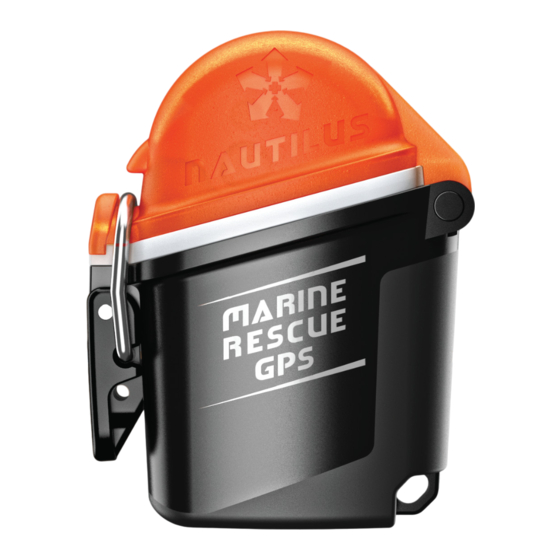
Table of Contents
Advertisement
Quick Links
Advertisement
Table of Contents

Summary of Contents for Nautilus Lifeline Marine Rescue GPS
- Page 2 Hold the red button for 5 seconds to begin distress transmission. * Be cautious when removing antenna retainer. The antenna may spring out rapidly. The Nautilus LifeLine is an aid to your safety. It is not a life-saving device. It is not intended to save your life.
- Page 3 IMPORTANT! The Nautilus LifeLine is an aid to your safety. It is not a life-saving device. It is not intended to save your life. Performing a test will reduce the This equipment is intended for battery life. Only perform a test once emergency use.
- Page 4 Power Button (On/Off) - Blue Dive Cap Dive Cap Clasp Help Button - Red Test Button - Yellow Latch Nautius LifeLine Marine Rescue GPS Online Manual Nautilus LifeLine Proprietary Tool www.NautilusLifeLine.com Marine Rescue GPS (Antenna winder) Proudly made in Canada +1 (604) 241-1918 www.NautilusLifeLine.com...
-
Page 5: Operation
OPERATION Batteries Not Included How to remove antenna retainer Warning: DO NOT Ensure that your pull up LifeLine GPS has two CR123 batteries installed. Batteries should be within Pull forward only the marked expiry date. to remove antenna retainer Open the dive cap by releasing the latch Press the blue button: LifeLine GPS goes to ON standby state and GPS attempts to lock Pressing the blue button again powers off the LifeLine GPS •... - Page 6 Note: Not required for use of the red Help button REGION CONFIGURATION (COMING SOON) MMSI PROGRAMMING (Android) Download and install Nautilus LifeLine GPS MMSI Programming App from Google Play or Apple iTunes Start the App and enter Own Ship’s MMSI, Group MMSI, and if desired, AIS...
-
Page 7: Test Sequence
TEST SEQUENCE Note: Test should be done at a temperature between 10-30 degrees Celsius. Press and hold LifeLine GPS Test Button for 5s till ORANGE indicator on Solid Releasing TEST button the ORANGE indicator will flash with the same rate as BLUE indicator •... -
Page 8: Battery Information
BATTERY INFORMATION The batteries should be replaced per the battery vendor's expiry date as printed on the batteries and recorded on the back label or after TEST mode battery change notice (alternating RED and Yellow LEDs). Replacing the batteries requires a Philips #1 head screw driver and a clean, non lint surface. -
Page 9: Specifications
SPECIFICATIONS AIS Transmit Power: 1 Watt AIS Frequency: 161.975 and 162.025 MHz DSC Transmit Power: 0.5 Watt DSC Frequency: 156.525 MHz Messages: Individual Distress Relay, Distress Alert Environmental Temperature Range: -20°C ~ +55°C Waterproof Depth: 425 feet (130 meter) sea water Dimensions: 2.9 x 3.8 x 1.5 inch (75 x 97 x 39mm) Weight: 4.6 oz (131g) with batteries This radio device is designed to only provide an effective...